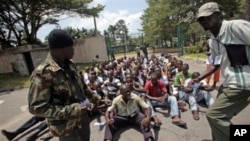As fighting and violence spread in Ivory Coast, areas of safe haven are shrinking. Humanitarian agencies are finding it harder to provide aid or help frightened civilians evacuate to neighboring countries.
Many displaced people are now stranded in the west of the country, says Jemini Pandya, spokesperson for the International Organization for Migration.
“Conflict between rival forces has now actually reached the western town of Guiglo, where we used to have an operational presence up until Tuesday of this week, when we had to evacuate our staff because of the fighting,” she says.
Seeking shelter where there is none
“About 4,000 people have now sought refuge in a former camp for the internally displaced that IOM used to manage until it closed in 2008. What we know so far is that those people who have gone to this area are mainly Burkinabes, but also Malians, Ghanaians, as well as Ivoirians. And the site at the moment is an empty one, because after the camp was closed everything had to be razed to the ground,” she says.
Pandya says that means no food, water, shelter or medical care.
“What’s particularly worrying,” she says, “is that now the rainy season has started. So if they’ve got no way of protecting themselves, then they’re going to be out there in the full face of the elements.”
Unable to reach the displaced at the former camp, the IOM has asked the U.N. peacekeeping mission in Ivory Coast (UNOCI) for help. Some troops are reported on their way to offer some protection.
Meanwhile, in Abidjan…
The situation isn’t getting any better in the commercial capital, either.
“The fighting continues to spread. We noticed some days ago that the city was rapidly emptying. People were just grabbing hold of whatever transport they could find in order to get out of the town,” she says.
The IOM is having difficulty getting an exact figure on the number of displaced in Abidjan. An earlier estimate put the figure at between 200,000 and 300,000.
“We still cannot access these populations,” she says. “What we do know is that there are about 19,000 people who are currently displaced in churches, schools and other buildings, with another 60,000 people staying in host families. But we know for a fact that the level of displacement is much, much greater than that. We just can’t provide a more definitive figure on that.”
With so many people trying to leave the city, the IOM is finding fewer available vehicles to use in its own evacuation program for migrant workers.
“IOM has now been asked to help return at least 35,000 Ghanaians, Malians, Senegalese, Burkinabes, as well as the Mauritanians, by their governments or community groups. And we are getting more requests for assistance coming on a daily basis,” she says.
The IOM is again urgently appealing to donors for immediate funds for its evacuation efforts.
Going to Ghana
Up until last week, few refugees had crossed the border into Ghana. Not anymore.
Pandya says, “Out of the nearly 2,000 Ivorian refugees who are now in Ghana, more than 1,400 arrived in this one week alone.”
The border crossing at Takoradi is overcrowded. The reception and transit center, which has a capacity of 200 to 300 people, is jammed with 800.
Many French-speaking migrants in Ghana say they want to travel on to Togo, which is also a Francophone country. Most migrants arriving in Ghana do not have any documents and their embassies may a day’s drive away in Accra.
Liberia
The Liberian border is a volatile one, with much fighting between forces loyal to Laurent Gbagbo, who the U.N. says lost the presidential election, and Alassane Ouattara, who the international community says won. Gbagbo has refused to step down.
The Norwegian Refugee Council is one of the many agencies helping the Ivoirians who’ve crossed the border, especially to Nimba County. Their exact numbers may be in question.
Country Director Astrid Sletten says, “In Nimba County, approximately 40,000 crossed…in the period beginning in December until about the 24th of February. After that there was a huge influx where another 45,000, give or take, crossed since the 25th of February.”
There’s a reason the agency has before and after dates.
“We suspect a lot of the cases registered after the 24th of February are already registered and we need to reconcile the data bases in order to determine how many refugees are actually in Nimba County as of now. But it’s [at a] minimum in the neighborhood of about 50,000.
Pro and con
There are indications of who has the upper hand in fighting along the border. Sletten says pro-Ouattara refugees are feeling more comfortable about returning home. But not so pro-Gbagbo refugees.
“On the other side of the border it’s very clearly Forces Nouvelles who’s in control, pro-Ouattara people. So, in fact, we see a very clear trend that the pro-Gbagbo people are not feeling safe even in the border areas. So, they are the ones opting to move to the camps,” she says.
Most of the refugees now crossing into Liberia are not heading for Nimba County, but rather for Grand Gedeh County. There’s fighting along that part of the border area forcing some 16,000 people to cross in recent days.
Many of the late arrivals are in worse condition than their predecessors because they’ve been on the run. Some have been treated for gunshot wounds. There are also reports of armed men following the refugees and attacking them. The identity of the gunmen is unknown
Also, more Ivoirian children are arriving malnourished.








